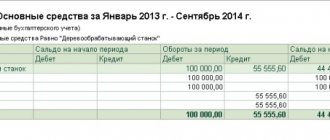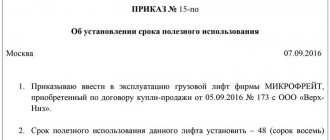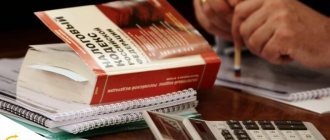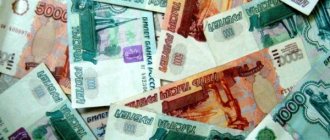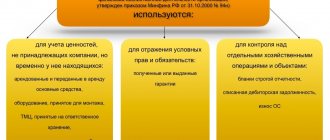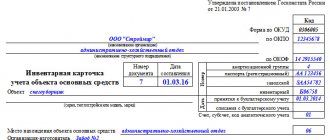What are fixed assets
Fixed assets are property owned by the company or attracted by it from the outside, which is used in its production activities for more than one year and has a value above the limit established by regulations.
There are criteria by which the distinction is made between fixed assets and other property.
How OS can take objects into account:
- Use time over 12 months.
- Such property is used by the company during its activities for production, provision of services, performance of work, or for enterprise management purposes.
- It was purchased for use, not for subsequent sale.
- Its use will allow the organization to generate income.
It follows that buildings, structures, vehicles, equipment, etc. are taken into account as OS.
The leading regulatory act governing the accounting of fixed assets in Russia is PBU No. 6/01. This document defines the indicators for classification as fixed assets, as well as the accounting methodology.
Attention! Among the above-mentioned features of an OS, another important criterion is not indicated - its price. According to PBU, fixed assets must include property whose purchase price is set at 40,000 rubles. For tax accounting, as specified in the Tax Code of the Russian Federation, the price of an object that will be used as fixed assets must be from 100,000 rubles.
Types of cost of fixed assets
There are several types of valuation of fixed assets:
- the initial cost of fixed assets is the cost at which fixed assets are accepted for accounting;
- replacement cost of fixed assets - value as a result of revaluation. Reflects at what cost the organization could purchase a similar fixed asset at the present time;
- residual value of fixed assets . It reflects the cost of fixed assets taking into account accrued depreciation. It is at this cost that fixed assets are reflected on the enterprise’s balance sheet (Form 1);
- salvage value - the value at which fixed assets can be sold after the expiration of their useful life.
Drawing. Types of cost of fixed assets
Types of fixed assets
Since OS objects are diverse, they are most easily classified into different groups. This division is important because, according to established standards, there are some features of accounting and transferring the price of an object to the final product of the company’s activities.
The following operating systems are distinguished:
- Building.
- Structures (temporary buildings, bridges, etc.).
- Transfer devices.
- Cars and equipment.
- Vehicles.
- Tools.
- Inventory and accessories.
- Other (not included in any of the above groups)
In addition, operating systems can be divided into production and non-production objects, based on their purpose. According to their ownership, they can be owned or rented.
Attention! Other divisions of OS may also be applied - according to the degree of action during the production process, according to the time of application, according to the transfer of the price to the final product, etc.
What has changed in 2021
The government has introduced the following changes from 2021:
- Starting from January 1, 2021, some changes were made to the Tax Code of the Russian Federation, Art. 259.3, clause 1 - expanded the list of equipment operated under the best available technologies. This equipment is depreciated with an increasing factor of two.
- A new list of equipment for accelerated depreciation was approved in accordance with Government Decree No. 622-r 04/07/2018.
Attention! Now 583 items of equipment fall under accelerated depreciation, i.e. There are now 2 times more positions than before (there were 246).
Fixed assets in 2021 – major changes
It was expected that from the beginning of the year there would be significant changes in the accounting of fixed assets. But new regulations were never adopted. Therefore, the old rules continue to apply for a significant number of OS objects.
However, there are some innovations, which, for the most part, affected small businesses that carry out accounting according to a simplified scheme.
Such entities received the right to create the initial cost of the fixed assets based on the amounts of payment to suppliers and contractors installing this facility. If the OS was created in the organization itself, then its price is formed from the amounts paid to contractors and other organizations. All other amounts spent can be transferred to current expenses.
Important! An organization has the right to depreciate fixed assets using a simplified regime once a year on the last day of the year.
Also, business entities with simplified accounting schemes received the right to immediately depreciate at full price fixed assets related to inventory (they have a low price and a short service life). Such measures allow such entities to reduce the burden when calculating property taxes.
You might be interested in:
Account 68 in accounting - calculations of taxes and fees: characteristics, subaccounts, typical transactions
In the current period of time, a new classifier of fixed assets has been adopted for use by groups for tax accounting, used to distinguish objects by depreciation groups. Individual objects were transferred from one group to another, and as a result, their depreciation rates will change.
Accounting for the cost of fixed assets in accounting
Currently, the principles of accounting for fixed assets for tax and accounting purposes differ.
Accounting for fixed assets in the accounting approach is regulated by the Accounting Regulations “Accounting for Fixed Assets” PBU 6/01.
From an accounting point of view, the significant cost of a fixed asset is 40,000 rubles. Moreover, if the fixed asset costs less than 40,000 rubles, then the enterprise can go in two ways:
- include fixed assets in the inventory;
- include in fixed assets and charge depreciation.
Accounting and tax accounting of fixed assets in 2021
One of the important indicators of accounting for an object as fixed assets is its initial cost. For accounting it is defined as 40,000 rubles, for tax accounting – 100,000 rubles.
Based on these differences, there are some features of accounting for OS objects.
OS costing up to 40 thousand rubles
This kind of OS is usually called low-value, since they have a low cost, but are used in activities for quite a long time.
The company has the opportunity to either immediately write off these fixed assets as inventories or register them as fixed assets and depreciate them. This rule applies to both accounting and tax accounting. However, the company must establish the method used in its accounting policies.
OS costing from 40 to 100 thousand rubles
OS objects with a price ranging from 40,000 rubles to 100,000 rubles are included in the intermediate group.
In accounting they are defined as fixed assets, and in tax accounting as low value.
Therefore, in the first situation, the company needs to register the object (accept for operation) and amortize its price according to the existing methodology.
In tax accounting, a company has the opportunity to transfer the costs of its purchase (production) instantly or take it into account and depreciate it. For tax accounting purposes, the company must also document the adopted method in its accounting policies.
The cost of the OS is more than 100 thousand rubles
The limit of 100 thousand rubles is not used in accounting. There, any property with a price exceeding 40 thousand rubles will be recognized as an asset. However, this has significant implications for tax accounting.
For the purposes of this accounting, fixed assets that were registered later than December 31, 2015, and less than this limit, can be immediately transferred to expenses. If its price is more than 100 thousand rubles, then the object will have to be depreciated using one of the two proposed methods.
Accounting for receipt of fixed assets (documents, postings)
- if necessary, make claims to persons responsible for damage, destruction or loss of property for compensation for damage caused to the organization (damage in this case may be expressed in the costs of repair and restoration of property, early acquisition of similar property).
If an organization does not keep records of written-off but exploited property, then the consequences may be: the likelihood of proving the validity of expenses for repairs and operation of unaccounted for property; uncontrolled acquisition of new property similar to the one written off, and the likelihood of proving the validity of such expenses; the obligation to register unaccounted property identified as surplus as a result of inventory, and accordingly increase taxable income; the impossibility of bringing to justice those responsible for damage and destruction of the organization’s property.
How to capitalize fixed assets worth less than 40,000 Typical accounting entries Based on accounting policies, taken into account as part of the inventory Dt 10 Kt 60, 76, 71 - low-value property acquired, Dt 19 Kt 60, 76 - VAT allocated on acquired low-value property, Dt 68 “VAT calculations” » “Calculations for VAT” Kt 19 - VAT is written off to be credited to the budget, Dt 10 Kt 60.76 - the costs of delivery, loading and other expenses associated with the acquisition of low-value property are reflected; Dt 19 - Kt 60, 76, subaccount “Calculations for VAT” - VAT is allocated for the amount of actual expenses associated with the purchase of low-value property; Dt 68 “Calculations for VAT” Kt 19 - VAT is written off and credited to the budget; Dt 20 (23, 25, 26, 44) Kt 10 low-value property transferred to operation. Dt 012 - low-value property is taken into account off the balance sheet.
Low-value" fixed assets Russian accountant, N 5, 2012 Elena Vidunets, magazine expert From January 1, 2011, fixed assets with a value not exceeding 40,000 rubles. per unit (before January 1, 2011 - 20,000 rubles), paragraph 5 of PBU 6/01 is allowed to be taken into account as part of inventories. That is, in accounting, these assets can be taken into account both as part of current and non-current assets. Let's talk about the nuances of accounting. To do this, the organization should set a specific cost limit not exceeding 40,000 rubles, and also register it in its accounting policy (clause 7 of PBU 1/2008 “Accounting Policy of the Organization”, clause 5 of PBU 6/01). Having determined the procedure for accounting for low-value property, the organization must adhere to it in relation to all objects that will meet the selected cost criterion.
Depreciation of fixed assets in 2021
The cost of the operating system must be transferred in small shares to the manufactured products or work performed. This process is called depreciation.
In 2021, the new OS and OKOF classifiers were adopted for use. Although the number of groups remained unchanged, some objects were moved from one to another. As a result, the norms of annual and, accordingly, monthly depreciation calculations change.
There is a group of fixed assets that do not need to be depreciated. These include land plots, natural objects, museum objects and collections, etc. Such a list is indicated in PBU 6/01.
Depreciation is determined from the 1st day of the month following the month in which the asset was taken into account. The process must be stopped from the 1st day of the month following the month in which this OS was deregistered (it was written off, sold, etc.).
In 2021, four methods of determining depreciation can still be used for accounting purposes:
- Linear;
- By reducing balance;
- Write-off based on the amount of the number of years;
- Proportional to the volume of products produced.
You might be interested in:
Depreciation of fixed assets: what is it, groups of fixed assets, methods of calculation in accounting in 2021
For tax accounting purposes, it is also allowed to use two methods:
- Linear;
- Nonlinear.
It is necessary to stop determining depreciation in the following situations:
- A three-month preservation is carried out;
- Reconstruction is in progress;
- OS under repair;
- Modernization lasts more than 1 year.
Attention! New directories should only be used for objects that began to be used in 2021 and later. There is no need to make corrections to the accounting cards of all previously accepted fixed assets and recalculate their depreciation. This rule is mandatory for both accounting and tax accounting.
What's new in the rules for tax accounting of fixed assets in 2017–2018
An innovation for 2021 is a new classification of fixed assets included in depreciation groups, based on the new OKOF (Order of Rosstandart dated December 12, 2014 No. 2018-st, Government Decree of the Russian Federation dated January 1, 2002 No. 1 as amended by Government Decree dated July 7, 2016 No. 640) .
NOTE! The new classification of fixed assets, applied from 2021, is intended only to determine the useful life of fixed assets for the purpose of calculating income tax. Decree of the Government of the Russian Federation dated July 7, 2016 No. 640, para. 2 clause 1 of the Decree of the Government of the Russian Federation dated 01.01.2002 No. 1, providing that the classification of fixed assets can be used for accounting purposes, is excluded.
In the new classification, fixed assets are grouped differently:
- the codes and names of fixed assets have changed;
- objects were added that were not in the old classification;
- Some items have been moved from one depreciation group to another.
For example, trucks with a carrying capacity of 3.5 to 5 tons in the old OKOF were included in the 4th depreciation group (SPI - from 5 to 7 years), and in the new one they belong to the 5th depreciation group (SPI - from 7 to 10 years).
Naturally, in such a situation, accountants asked questions: what SPI is used for fixed assets put into operation before 01/01/2017 and is it necessary to recalculate income tax on objects for which the SPI has changed? Accountants were able to see the answers to these questions in the letter of the Ministry of Finance of the Russian Federation dated November 8, 2016 No. 03-03-RZ/65124, in which it was explained that in relation to fixed assets put into operation before January 1, 2017, the SPI determined by the taxpayer when introducing them is applied into operation (letter of the Ministry of Finance of the Russian Federation dated November 8, 2016 No. 03-03-RZ/65124).
In 2021, companies have the opportunity to reduce their income tax (or advance payments for this tax) by using an investment tax deduction. The company can choose the method of writing off the cost of the operating system:
- calculate depreciation;
- or apply an investment deduction.
Find out more from the publications:
- “Investment tax deduction - a new opportunity to optimize income tax”;
- “Investment tax deduction for income tax from 2018.”
What documents are used to account for fixed assets
When documenting, a company can use either standard documents offered by Goskomstat or those developed independently. Whatever forms are used, they must be specified in the accounting policy.
Standard forms are divided into several groups:
| Form number | Name | What is it needed for |
| Admission and departure | ||
| OS-1 | Certificate of acceptance and transfer of fixed assets (except for buildings, structures) | To record the inflow and outflow of individual fixed assets, it is not filled in for buildings and structures. |
| OS-1a | Certificate of acceptance and transfer of a building (structure) | To record the arrival and disposal of buildings and structures |
| OS-1b | Act on acceptance and transfer of groups of fixed assets (except buildings, structures) | If the recording of the arrival and departure of fixed assets (does not apply to buildings, structures) is performed immediately for the group |
| OS-14 | Certificate of acceptance (receipt) of equipment | Accounting for equipment in storage that will be used in the future |
| OS-4 | Act on write-off of fixed assets (except for vehicles) | Write-off of certain OS objects that have become unusable. Not to be filled out for vehicles. |
| OS-4a | Act on write-off of motor vehicles | Write-off of a vehicle that has become unusable |
| OS-4b | Act on the write-off of groups of fixed assets (except for vehicles) | Write off the OS group immediately, not filled in for vehicles |
| Availability and movement | ||
| OS-6 | Inventory card for recording a fixed asset item | Accounting for certain fixed assets and their movement within the company |
| OS-6a | Inventory card for group accounting of fixed assets | Accounting for several similar operating systems |
| OS-6b | Inventory book for accounting of fixed assets | In small enterprises it replaces filling OS-6 and OS-6a |
| OS-15 | Certificate of acceptance and transfer of equipment for installation | Transferring the OS stored in the warehouse for installation |
| OS-16 | Report on identified equipment defects | Recording of defects that were identified during installation, testing, etc. |
| OS-2 | Invoice for internal movement of fixed assets | Recording the movement of assets between departments within the company |
| OS-3 | Certificate of acceptance and delivery of repaired, reconstructed, modernized fixed assets | Registration of OS upon completion of repairs and modernization |
Accounting entries
Transactions with fixed assets are reflected in accounting with the following entries:
| Debit | Credit | Operation name |
| Receipt of fixed assets | ||
| 60, , , 69 | The expenses incurred for the acquisition or creation of OS are recorded in accounting | |
| 07 | 60, 10, 70, 69 | The costs of preparing the installation of the OS and its installation are recorded in accounting |
| 08 | 07 | Installation costs transferred |
| 19 | Input VAT on fixed assets costs is recorded in accounting | |
| 68 | 19 | Input VAT is accepted for deduction |
| 01 | 08 | The OS object is accepted for accounting |
| Depreciation | ||
| 20, 23, 25, 26, 29, 44 | 02 | Depreciation of fixed assets was calculated based on the direction of their use |
| Restoration, modernization, repair | ||
| 08 | 60 | The price of a third-party company for repairs and OS upgrades has been fixed |
| 19 | 60 | VAT recorded on contractor's work |
| 08 | 10, 70, 69 | Repairs and modernization of the OS were carried out on our own |
| 08 | All expenses incurred are written off to increase the cost of the operating system. | |
| Sale | ||
| 91 | Income from the sale of fixed assets is recorded in accounting | |
| 91 | 68 | VAT recorded on sales |
| 02 | 01 | Accrued depreciation written off |
| 91 | 01 | The residual value of the asset is written off |
| Liquidation | ||
| 01 | Depreciation on the liquidated asset has been written off | |
| 91 | 01 | Residual value written off |

